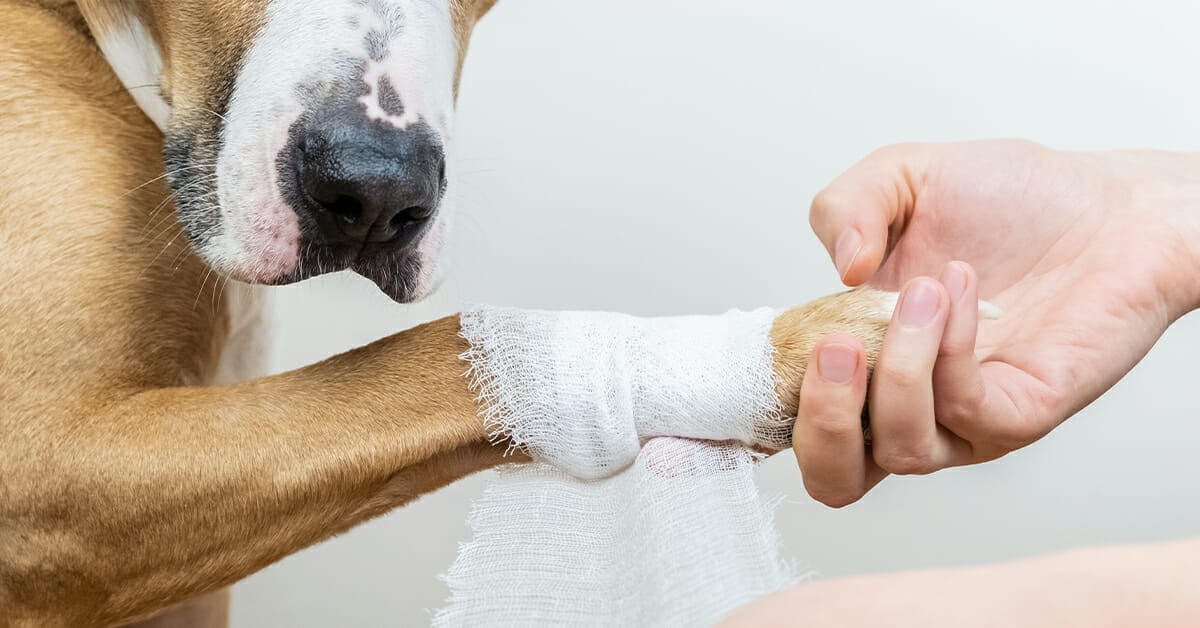
What You Should Know About Snake Bites and Your Pet
If your pet is bitten by a snake, knowing how to respond can make all the difference for your pet’s wellbeing.
The sun is shining, and the outdoors are calling! Whether you’re enjoying a hike or a pleasant afternoon in the yard with your pet, it’s important to remember that snakes also enjoy the warmer weather. A curious pet and a venomous snake can be a dangerous combination, potentially leading to life-threatening snake bites. In this blog, our MedVet experts will share signs that your pet may have been bitten by a snake, tips for avoiding snakes, and what to do if your pet is bitten.
Avoiding Snake Encounters
While snake bites can sometimes be unavoidable, there are several ways to reduce the chances of encountering a snake. If you come across a snake (or even hear a rattle), slowly move away from the area.
In the Yard
- Check your pet for injuries when you bring them inside.
- Keep your yard clean and free of potential hiding spots. Snakes often hide in piles of leaves, wood, or other debris.
- Keep the grass mowed to deter snakes from entering.
- Monitor your pet while they are outside.
- Consider installing a snake-proof fence around your property, particularly if you live in an area where venomous snakes are common. This can be a more permanent solution to keep snakes out of your yard.
While Hiking with Dogs
- Stick to well-hiked trails. Snakes generally want to avoid humans and dogs, so they are more likely to stay away from busy areas. Snakes are most active during the warmer months and at dawn and dusk. Try to avoid these times when you are in snake-prone areas.
- Keep your dog on a short leash and stay close together. This is especially important in tall grass, rocky areas, or near water sources.
- Look ahead on the trail and observe your surroundings. Some snakes blend in seamlessly with their environment.
- Stay on cleared, open sections of trails. Thick brush, large rocks, and fallen logs provide perfect hiding spots for snakes.
- Use trekking poles to enhance your workout and allow you to push back brush that might be overhanging the trail, which can be a favorite sunny spot for snakes to rest.
- Know the location of the nearest emergency veterinary hospital, like MedVet, and have their contact information handy. Know the route to the clinic and the quickest way to get there in an emergency.
- Carry a first aid kit, including items like a tourniquet, antiseptic wipes, and a snake bite kit if you are in a high-risk area. For more information on what to include in a pet first aid emergency kit, visit our blog post.

It is also helpful to know what types of venomous snakes are common in your area to better understand where they may be found and their behavior. A-Z Animals has a guide to identifying venomous snakes in the United States.
Signs Your Pet May Have Been Bitten by a Snake
Snake bites are most common on the face and legs. The snake typically leaves two puncture marks, which can be so tiny that they are hard to see. If the bite is surrounded by fur or in a hard-to-see location, it may be especially difficult to locate the marks. Many pet owners do not realize their pet has been bitten until they notice swelling and signs of pain, such as limping.
Initial signs of a snake bite may include:
- Puncture wounds (possibly bleeding): Venomous snake bites often leave two distinct puncture wounds, which are the marks of the snake’s fangs. Non-venomous bites may leave a series of small, shallow punctures.
- Swelling and redness: One of the most immediate and visible signs of a snake bite is swelling and redness at the site of the bite. The area may become inflamed and painful, and the swelling can spread rapidly.
- Excessive drooling and panting: Pets may drool or pant excessively due to pain or the effects of the venom.
- Severe pain and changes in behavior: Your pet might become unusually aggressive, anxious, or show signs of confusion. These behavioral changes can be indicative of a snake bite.
Signs that may develop over time include:
- Bleeding and bruising: The bite site may bleed or bruise, and in some cases, there might be a discharge of blood or other fluids.
- Lethargy and weakness: Your pet may become lethargic, weak, or show signs of distress. They might be less active than usual and have difficulty standing or walking.
- Vomiting and diarrhea: Some pets may experience gastrointestinal symptoms such as vomiting and diarrhea. These can be signs of a systemic reaction to the venom.
- Seizures: In extreme cases, venom can cause seizures or convulsions. This is a severe symptom that requires immediate medical intervention.
- Shallow breathing: In severe cases, venom can affect the respiratory system, leading to difficulty breathing. This is a critical sign that requires immediate veterinary attention.
- Collapse: If the venom is highly potent, your pet might collapse or lose consciousness. This is a life-threatening situation and should be treated as an emergency.
What to Do if Your Pet Has Been Bitten by a Venomous Snake
Bites from venomous snakes are a painful and potentially life-threatening medical condition. However, snakebites in pets are rarely fatal when treated quickly by a veterinarian. If your pet is struck by a snake, many MedVet locations are open 24/7 to provide supportive care.
Here are some tips to help your pet while you seek medical assistance:
- Stay calm. Realize that a venomous snake bite is scary, but maintaining your composure can help your pet receive care faster.
- Seek emergency veterinary care immediately. The sooner your pet receives emergency care and, if possible, antivenom, the greater their chance of survival.
- Carry your pet to the car. If you are able, carry your pet to the car. If not, walk slowly to inhibit the spread of snake venom through their body.
- Keep your pet cool and hydrated. Ensure your pet stays cool and has access to water.
- Avoid touching the bite area. Touching the bite area can cause your pet pain, so try to avoid it.
It is important to note that there are no over-the-counter medications that can safely alleviate the effects of a snake bite. Always seek professional veterinary care.

Treating Pets with Snakebite
Pain medication, intravenous (IV) fluids, and antivenom can help your pet recover and reduce discomfort.
Antivenoms (also called antivenins) are the best treatment to minimize swelling and reduce the severe complications that can result from a venomous snake bite. These are purified antibodies that work directly against the venom to neutralize its toxic effects on tissues. Antivenom can prevent severe localized swelling and pain, and greatly reduce the risk of tissue damage, shock, or blood clotting issues.
Most veterinary emergency facilities, including MedVet, and some general practice veterinarians keep antivenom/antivenin on hand. If you are unsure, call the hospital before bringing your pet in to confirm availability.
If you notice any of these signs or if you believe your pet is having a medical emergency, contact your family veterinarian immediately or find the nearest emergency veterinary hospital, such as MedVet. Prompt medical attention can help ensure your pet’s safety and wellbeing.
Visit our Pet Care Resources library for more pet health and safety information.
FAQs
How can my pet avoid snakes in my yard?
How can I keep my dog safe from snakes while hiking?
What are signs my pet may have been bitten by a snake?
What should I do if my pet has been bitten by a snake?
Learn More
For ways to ensure your pet lives a happier, healthier life, visit our Pet Care Resources library.
Pet Care ResourcesContents
Learn More
For ways to ensure your pet lives a happier, healthier life, visit our Pet Care Resources library.
Pet Care Resources

